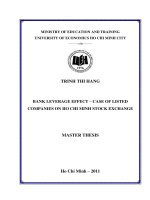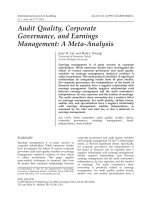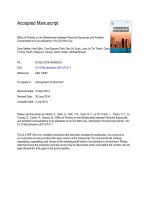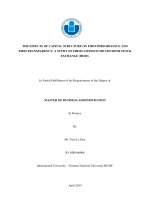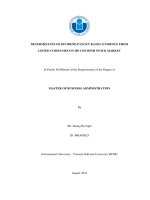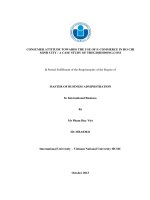The effect of corporate governance on earnings management of enterprises listed on Ho Chi Minh stock exchange, Viet Nam
Bạn đang xem bản rút gọn của tài liệu. Xem và tải ngay bản đầy đủ của tài liệu tại đây (319.97 KB, 11 trang )
Hue University Journal of Science
ISSN 1859-1388
Vol. 113, No. 14, 2015, pp. 5-15
THE EFFECT OF CORPORATE GOVERNANCE ON
EARNINGS MANAGEMENT OF ENTERPRISES LISTED ON
HOCHIMINH STOCK EXCHANGE, VIETNAM
Le Thi Hoai Anh*, Le Thi Nhat Linh, Vu Thanh Huy
College of Economics, Hue University
Abstract: This paper examines the effect of corporate governance mechanism on earnings management of
130 enterprises traded on Ho Chi Minh Stock Exchange (HOSE), Vietnam in 2014. Earnings management is
measured by discretionary accruals, and corporate governance is characterized by the CEO duality, board
size and board independence. Based on this study, recommendations are made to the policy-makers and
standard setters to contribute to limiting this practice in Vietnamese context. To achieve this objective, an
empirical analysis is conducted by using the multivariate regression model. The results indicate that while
CEO duality and board size are positively correlated with the extent of earnings manipulation, there is no
association between board independence and this variable.
Keywords: Earnings management; corporate governance; discretionary accruals; HOSE
1
Introduction
Earnings difference before and after auditing is a typical issue reflecting earnings management
practices of Vietnamese listed firms [4]. In the 2014 season of auditing report release, this issue
was getting more serious and made investors upset when reported earnings of many companies
dramatically increased or decreased after auditing, from loss to profit or vice versa [6]. Typically,
Petro Vietnam Construction Joint Stock Corporation (PVX) shocked the market by announcing the
audited consolidated earnings after tax dropped nearly VND 70 billion, from VND 80.08 billion to
VND 10.31 billion; or Construction Joint-stock Company No. 5 (VC 5) reported a loss of VND
17,235 billion instead of a profit of VND 268 million [6]. Earnings manipulation, regardless of
underestimation or overestimation, can mislead users of disclosed information in making such
important economic decisions as investment, loan or tax [5]. This practice is seriously eroding
users trust on the reliability of information on financial statements Therefore it is a big concern
of the accounting academic, practitioners, standard setters and policy-makers.
Literature review indicates that certain accounting research has begun to turn to corporate
governance to explain the existence and determinants of this behavior due to the conflict of
interests between shareholders (principals) and managers (agents) [28]. On one hand, managers
often prefer fostering their personal benefit to serving shareholders purposes On the other hand
companies do not have owners in the traditional sense Despite shareholders right to manage the
company by participating in and voting during, the annual general meeting, they act as investors,
not owners. While owners focus on the firm performance, investors focus on the risk and return of
their stock portfolios. Therefore, investors tend to be inactive shareholders in many firms [19]. As
a result, stakeholders always obtain less obvious and later information than their agents. This
*Corresponding:
Submitted: November 30, 2015; Revised: December 12, 2015; Accepted: February 25, 2016.
Le ThiHoai Anh et al.
Vol. 113, No.14, 2015
makes difficult for them to make timely and right decision. Therefore, it is necessary for the
government to establish the regulation on the roles of all actors in the companies to improve
manager s control and enhance the reliability of financial information “mongst the internal
corporate governance mechanism, the board of directors is regulated to ensure the interest of
shareholders, and managers are closely aligned [25]. Thus, the board is important to ensure that
investors are not led into suboptimal resource allocation decisions based on a view of the
accounting numbers as information [22]. While Chief Executive Officer (CEO) duality, board size
and independence have been a growing research area, the board is expected to have a special role
in assuring that the company s decisions respect the law and regulations especially with earnings
management activities.
In summary, the objective of this paper is to examine the relation between corporate
governance and earnings management behavior of Vietnamese firms listed on HOSE. Based on
this study, suggestions are made to support users in making right investment decisions and
facilitate policy makers, standards setters in setting new policies to limit this behavior.
The structure of this paper is as follows: First, a brief literature review and hypotheses
development are discussed, followed by the explanation of research methods. Next, the analytical
results are presented. And finally, main points are concluded along with recommendations and
limitations.
2
Literature Review and Hypotheses Development
2.1
Earnings Management
Earnings management can be defined in many different ways From some scholars viewpoints
managers manipulate earnings to publish more informative disclosure and obscure the
unpleasant reality Typical for this perspective is Healy and Wahlen s definition earnings
management occurs when managers use judgment in financial reporting and in structuring
transactions to alter financial reports to either mislead stakeholders about the underlying
economic performance of the company or to influence contractual outcomes that depend on
reported earnings
p
From another viewpoint Schipper defines earnings management as
a manager s intervention in financial information to get personal benefit This definition points
out the manipulation results in managers opportunistic behavior Consistent with this argument
Zgarni, Halioui&Zehri (2014) confirmed that this action is undertaken for the benefit of
management, not for stakeholders [28]. Regardless of any viewpoint, this behavior is inconsistent
with Generally Accepted Accounting Principles (GAAP), significantly inflates net profit [11] and
misleads investors, creditors or any party interested in the financial information [8].
2.2
Corporate Governance
The principles of good corporate governance are as old as good behavior, which needs no formal
definition. However, building relevant codes and strong laws of corporate governance is the core
to improve manager's control as well as the reliability of financial information. According to
Nguyen (2014), corporate governance is the system by which organizations are directed and
6
Jos.hueuni.edu.vn
Vol. 113, No.14,2015
controlled by senior officers [1]. From this definition company s senior officers are accountable for
the corporate culture they create and must respect the rules they set out for other employees. For
example CEO must be responsible for the company s disclosure control and financial reporting.
Thus, the basic objective of corporate governance is to enhance, maximize the market value of the
company, shareholder value and protect the interest of other stakeholders. However, this goal is
usually not compatible with the interest of managers, as they prefer to maximize their personal
interest, even at the expense of owners. This discrepancy of interest leads to the agency conflict,
which is especially severe in public companies where the relationship between shareholders and
managers is based on contracts [18]. According to the agency theory, it is the separation of
ownership and control that causes these serious internal conflicts of interest. In this case, a
possible solution is the use of an effective corporate governance mechanism to deter manager s
abuse of authority in pursuing personal purpose misusing company s funds or manipulating
earnings.
2.3
Hypotheses Development
CEO Duality
CEO duality means someone acts as a CEO, while at the same time he or she is also the chairman
of the board [28]. According to the Regulation on Corporate Governance applied to firms listed
on stock exchanges and issued regarding to the Resolution 12/2007/QD-BTC the chairman of
the board is not allowed to hold concurrently the role of Chief Executive Officer, unless the
accumulation is approved at the annual General Meeting of Shareholders
However,
empirical results on the relationship between CEO duality and earnings manipulation are quite
controversial. On one hand, some scholars like Charfeddine, Riahi&Omri (2013) and Zgarni et al.
(2014) pointed out that the roles of CEO and chair should be separate. Otherwise, there is a
considerable concentration of power on the manager who might abuse for his personal benefit
[12]. The control exercised by the board will also be weakened, which means that the board is less
likely to constrain earnings management. Theoretically, these arguments are consistent with the
bonus-plan hypothesis of the positive accounting theory supposing that the management would
apply accounting policies that enable them to satisfy their interests [12]. Drawing on an empirical
research conducted on 100 Vietnamese listed enterprises, Pham (2012) also confirmed that the
separation of the chairman and CEO roles could contribute to limiting the extent of earnings
management [2]. On the other hand, Graven (2009) and Ahmed (2013) found no association
between discretionary accruals and the duality of the board [16][9]. To test e association between
these variables, the first hypothesis proposes that
H1: CEO duality is positively associated with earnings management.
Board Size
It is regulated by the Regulation on Corporate Governance that the board should have from five
to eleven members [3]. Interestingly, there is a dichotomy in literature on the impact of the
board size on earnings manipulation. Zgarni et al. (2014) argued that there was a significantly
positive association between the number of board members and the level of discretionary
7
Le ThiHoai Anh et al.
Vol. 113, No.14, 2015
accruals. This argument means that the more members of the board are, the higher the
occurrence probability of earnings management is. The reason might be a larger board has
greater power and resources to perform its duties; however, it is slow in making decisions and
more likely to oppose innovation. On the contrary, Karamanou and Vafeas (2005) debated that
firms with a larger board had higher-quality financial statements or lower level of earnings
management because they had better updates of management earnings forecasts. In addtion,
Pham (2012), Graven (2009) and Visvanathan (2008) found no association between the board
size and the level of earnings manipulation [24]. Therefore, to test the relationship between
them, the second hypothesis suggested that
H2: The size of the board is positively correlated with earnings management.
Board Independence
Literature review indicates that non-executive independent board members are motivated to
work for the best interest of shareholders [28]. Therefore, the higher the percent of nonexecutive members of the board is, the lower the extent of earnings management is. The
Resolution 12/2007/QD-BTC legalizes that one-third of the total board members is nonexecutive [3]. Nevertheless, research on the rapport between the board independence and
earnings management is argumentative. While the study of Pham (2014) pointed out that the
objectivity of the board is positively correlated with earnings management [2], Graven (2009)
found no correspondence between these variables [16]. However, somestudies of Zgarni et al.
(2014) or Beasley (1996) suggested that the percentage should be increased because it can reduce
the extent of earnings management [10]. Based on a study conducted on Taiwanese IPO firms
from 1994 to 2001, Jaggi, Chin, Lin, and Lee (2006) also discovered that a higher proportion of
independent director is associated with a more effective monitoring mechanism to constrain
earnings management [17].Based on these arguments, the third hypothesis is
H3: Board independence has a negative relationship with earnings management.
In conclusion, the above hypotheses proposed relationships between corporate
governance and earnings management. Besides, two control variables, namely firm size and
audit quality are examined in the multiple regression equation so that the estimated result will
not suffer from the omitted variable bias [23]. These two variables are considered in this study
because they were widely tested in the literature review and were found to significantly impact
earnings management.
3
Methodology
This study uses quantitative methods to evaluate the effect of corporate governance on earnings
management of Vietnamese companies. First, the data sources and collection are presented,
followed by the measurement of dependent and explanatory variables. Finally, the research
model used to test the hypotheses is defined.
8
Jos.hueuni.edu.vn
3.1
Vol. 113, No.14,2015
Data Sources
A sample of 130 Vietnamese companies is considered in this study. These sampled firms are
selected from the population of companies traded on the HOSE. Firms belonging to such
industries as banking, insurance, stock and investment fund are excluded because these sectors
use special accounting norms and have different mechanism of operation. This is a crosssectional study because the studied firms are observed for one financial year ended on
31/12/2014. The data are collected from annual reports, specifically, Income Statements and
Cash Flow Statements, collected from the website of the HOSE or each company [7].
3.2
Measure Earnings Management by Discretionary Accruals
Consistent with literature, discretionary accruals are used to measure earnings management
[12],[9]. According to Vietnamese accounting standards, the Income Statement is prepared
based on the accrual accounting. This means that the recognition of revenues and expenses will
not depend on the cash flow but the time transactions. The net income is the difference between
revenues and expenses. However, the Cash Flow Statement is prepared based on the cash
accounting, which means that the accountant is only allowed to recognize revenues and
expenses when they are really realized, earned or paid, but not when the time transactions
occur. Hence, the accrual is the difference between the net income in the Income Statement and
the net cash flow in the Cash Flow Statement as shown in equation (1)
Total Accruals = Net income - Net cash flow
(1)
In other words accruals are components of earnings that are not reflected in the current
cash flow
p
“ccording to Healy as cited in Young, 1998), total accruals are
composed into discretionary and non-discretionary elements [26]. Discretionary accruals (DA)
arise from transactions made or accounting treatment chosen to manage earnings
p
Non-discretionary accruals ND“ arise from transactions made in the current period that are
normal for the firm given its performance level, business strategy, industry conventions, macroeconomic events and other economic factors
p
The equation is as follows
TAit = DAit + NDAit
(2)
where for the firm i in year t, TAit is total accruals; DAit is discretionary accruals; NDAit is nondiscretionary accruals. From the equation (2), discretionary accruals are calculated as:
DAit = TAit - NDAit
According to De“ngelo s model
total accruals of last period
(3)
non-discretionary accruals of this period are
NDAit = TAit-1
(4)
where TAit-1 is total accruals of the firm iin year t- ”ecause this model examines the firm s
growth, total accruals are divided by total assets of last period (A it-1). Therefore, discretionary
accruals are computed as
DAit = (TAit TAit-1)/Ait-1
(5)
9
Le ThiHoai Anh et al.
Vol. 113, No.14, 2015
In summary, discretionary accruals of this year are the difference between total accruals
of this year and last year scaled by lagged total assets. This model is based on the assumption
that nondiscretionary accruals are constant. After calculating, the conclusion can be made in
three cases, if DAit = 0: earnings are not managed; DAit> 0: earnings are managed upwards;
DAit< 0: earnings are managed downwards.
3.3
Measurement of Variables
The variables used in this study are measured as presented in Table 1, with variable names in the
first column; expected signs of hypotheses in the second column and measurement levels in the
third column.
Table 1. Measurement of Variables
Expected
sign
Variables
Measurement
Dependent variables
DA
Ratio scale (discretionary accruals calculated by (5))
Independent variables
CEO_Dual
+
Nominal scale (two levels: 1 if CEO is also chairman of the board, 0
otherwise)
Board_Size
+
Ratio scale (number of board members)
Board_Ind
-
Ratio scale (percentage of non-executive independent board members)
Control variables
SIZE
+
Nominal scale two levels
is Small or Medium
AUDIT
-
Nominal scale (two levels: 1 if the firm is audited by Big4, 0 if by NonBig4)
3.4
if the firm size is Large
if the firm size
Research Model
In order to test the hypotheses H1 to H3, data collected from the financial and annual reports of
the sampled firms are analyzed through a statistical data analysis software package called
STATA. The population multiple regression equation is
DA =
0
+
1
CEO_Duali +
2
Board_Sizei+
Board_Indi+
3
4
SIZEi +
5
*AUDITi + i
(6)
*AUDITi
(7)
After running the regression, the estimated regression equation is
DA =
10
0
+
1
CEO_Duali +
2
Board_Sizei +
3
Board_Indi +
4
SIZEi +
5
Jos.hueuni.edu.vn
Vol. 113, No.14,2015
The coefficients 1, 2, 3, 4, 5 estimated from the regression model (7) are used to
explain the relationship between the corporate governance mechanism and earnings
management as well as to make conclusions about the proposed hypotheses.
4
Results and Discussion
4.1
Descriptive Statistics
Table 2 summarizes the descriptive statistics results of variables in the regression model.
Table 2. Descriptive Statistics
Variable
Obs.
Mean
Std. Dev.
Min.
Max.
DA
130
0.0490658
0.504025
-1.357351
4.98602
CEO_Dual
130
0.5538462
0.4990151
0
1
Board_Size
130
5.646154
1.598747
4
10
Board_Ind
130
0.5785959
0.2408216
0
1
SIZE
130
0.8307692
0.3764061
0
1
AUDIT
130
0.5153846
0.5016966
0
1
With regards to the dependent variable, DA, it indicates that the extent of earnings
management of firms listed on HOSE ranges from -1.35, which means a firm managed its
reported earnings downwards by 135% in 2014, to 4.98, and managed this figure upwards by
498%. Although the mean value of this variable is quite low (0.049), the standard deviation
(0.504) is relatively high. Therefore, it could be seen that earnings management level of studied
companies is relatively high. In terms of explanatory variables, first, the mean value of
CEO_Dual is 0.5538, which means that 55.38% of the CEO is also the chairman of the board of
directors in Vietnamese firms. Next, the figure on Board_Size reflects the average size of the
board that varies from 5 to 6, with the maximum of 10 and the minimum of 4 members, which
is quite different from the size range regulated by the Regulation on Corporate Governance that
the board should have from five to eleven members. Besides, the descriptive statistics of
Board_Ind shows the mean percentage of the independence non-executive board members is
about 57.85%, which is higher than one-third expected by the Resolution 12/2007/QD-BTC. With
the group of control variables, SIZE, as shown in Table 2, it can be found that 16.92 percentage of
selected firms (22 firms) has the firm size of small or medium and 83.08 percent (108 firms) is
classified as large companies. This classification is based on Clause 1, Article 3 of Decree No.
56/2009/ND-CP dated 30/6/2009 of the Vietnamese Government for small and medium-sized
enterprises.
11
Le ThiHoai Anh et al.
Vol. 113, No.14, 2015
Table 3. Descriptive Statistics of SIZE
SIZE
Freq.
Percent
Cum.
0
22
16.92
16.92
1
108
83.08
100.00
Total
130
100.00
Finally, the average value of AUDIT is 0.5153. As shown in Table 4, this variable has
taken 63 times the value 0 and 67 times the value 1, which means that 48.46% of the sampled
firms was audited by non-Big4 and 51.54% of the companies was audited by Big4.
Table 4. Descriptive Statistics of AUDIT
AUDIT
Freq.
Percent
Cum.
0
63
48.46
48.46
1
67
51.54
100.00
Total
130
100.00
4.2
Multivariate Analysis
Table 5 presents the regression results on the relationship between earnings management, which
measured by discretionary accruals and characteristics of corporate governance mechanism of
Vietnamese firms listed on HOSE. Table 5 indicates that the model is significant with an R2 of
15.43%.
In terms of the CEO and chairman roles duality, the coefficient 1 = 0.19586 and p-value =
0.048 show that the variable CEO_Dual is significantly positive with discretionary accruals at 1%
level. Therefore, the first hypothesis of this study is supported, which means that the
accumulation of the CEO function and the chairman in an enterprise will increase the extent of
earnings management. This empirical analysis result continues to confirm the bonus-plan
hypothesis of the positive accounting theory supposing that the management would apply
accounting policies that allow them to satisfy their interests, especially when they have more
power. This finding is consistent with the conclusion of Charfeddine et al. (2013), Sarkar, Sarkar &
Sen (2014) and Zgarni et al. (2014) on the positive impact of the CEO duality on earnings
management [21].
In the case of Board_Size, Table 5 also shows that the size of the board is positively
correlated with earnings management. It is significant at 1% level with the p-value of 0.045 and
the coefficient 2 = 0.0691626; this confirms the second hypothesis. Thus, it can be concluded
that size forms a motivation for managers to manipulate the earnings figures. This finding
confirms the conclusion of Yermack (1996) stating that small boards are more effective monitors
and controllers than large boards, which is associated with less earnings manipulation [27]. The
result is also consistent with the previous study of the scholars Zgarni et al. (2014).
12
Jos.hueuni.edu.vn
Vol. 113, No.14,2015
Table 5. Multivariate Analysis Results
Variable
Coefficient
p-value
Intercept
-0.8990808
0.075
CEO_Dual
0.19586
0.048***
Board_Size
0.0691626
0.045***
Board_Ind
0.0357139
0.509
SIZE
0.2901307
0.042***
AUDIT
0.1730387
0.026***
Adjusted R2
0.1543
N
130
Note:*, ** and *** represent statistical significance at 0.10, 0.05 and 0.01 levels respectively
In contrary to the findings of many researchers, the board independence (Board_Ind) is
found to be insignificantly associated with discretionary accruals with the coefficient 3 =
0.03571139 and the p-value of 0.509. Hence, the third hypothesis is rejected. This result points out
that the presence of independent board members will not really reduce earnings management
behavior and enhance the control mechanism. This finding is consistent with that of Graven (2009)
who also failed to detect any significant relationship between earnings management and
independent board [16].
In addition, the variable SIZE is found to be significant at 1% level with the coefficient 4
of 0.2901307 and the p-value of 0.042. This figures show that the firm size has a positive effect on
earnings management. Therefore, the larger the firm, the more likely the manager will
manipulate earnings downward figures to reduce political costs determined on the basis of
accounting figures. This result is consistent with conclusions of Charfeddine et al. (2013).
Finally, the variable AUDIT has a positive coefficient ( 5 = 0.1730387) and it is significant at 1%
level with the p-value of 0.026. This result is inconsistent with the study of Francis & Wang
(2008) concluding that Big 4 provides higher quality audits or less earnings management than
non-Big 4 [15].
5
Conclusion
This paper investigated the effect of corporate governance mechanism on earnings management
of 130 enterprises traded on HOSE, Vietnam in 2014. Three characteristics of board of directors
used to measure corporate governance and hypothesized to have the significant impact on this
practice have been tested by using the multiple variable regression analysis. The empirical
analysis reveals that two out of three factors considered are found to significantly affect earnings
management, with two variables (CEO duality and board size) that are defined to have a positive
association with earnings management. Therefore, it is possible to conclude that corporate
governance has a significant effect on earnings manipulation level of firms listed on HOSE. Based
13
Le ThiHoai Anh et al.
Vol. 113, No.14, 2015
on this study, two recommendations are made to policy-makers and standard-setters to contribute
to limiting this practice in Vietnamese context. First, from the research results of the impact of
CEO duality on the level of earnings mangement, it is suggested to the Ministry of Finance of
Vietnam that the role of CEO and chairman of board of directors should be regulated to be
separate into two independent people in a company. This separation will improve the
effectiveness of the board s monitoring function as well as constraining earnings management
behavior. Otherwise, there is a considerable concentration of authority on the manager who might
abuse for his personal benefit. Secondly, it is suggested that the number of members of the board
should be decreased to effectively control the firm.
However, the results and recommendations of this study should be interpreted in light of
some limitations which create a fruitful area for future research. First, while there are many
models to estimate discretionary accruals, such as Ronen and Sadan, 1981; Healy, 1985; DeAngelo,
1986; Dechow and Sloan, 1991; Jones, 1991 (Ronen and Yaari, 2008); Modified Jones model, 1995;
Kothari et al., 2005; Raman and Shaharur
this study employs De“ngelo s model
due to the feasibility of database in the Vietnamese context and research capacity of researchers.
The DeAngelo model (1986) is based on the assumption that nondiscretionary accruals are
constant. This assumption is unlikely to be empirically descriptive because the nature of the
accrual accounting shows that nondiscretionary accruals change in response to economic
circumstances [14]. Therefore, the Modified Jones model is recommended to measure earnings
management in future research. Secondly, this study only uses secondary data collected from the
available financial reports which cause limitations in understanding the research dilemma as well
as suggesting feasible solutions. Hence, it is recommended that the qualitative approach should be
employed by using surveys to collect more responses and opinions from managers and
accountants.
References
1. Nguyen Cong Tam (2014), Accounting and Auditing in Business, Ho Chi Minh National University
Publisher, Ho Chi Minh City.
2. Pham Thi Bich Van (2012). Corporate Governance and Earnings Management: An empirical study of
firms listed on HOSE. Journal of Science and Banking Education, 127, 58-66.
3. The Regulation on Corporate Governance applying to firms listed on stock exchanges, issued
according to the Resolution 12/2007/QD-BTC.
4. VACPA. (2011). Retrieved from
/>5. Vietnam News. (2012). Retrieved from />
taxes-with-transfer-pricing-ruse.html
6. Stock Investment. (2015). Retrieved from />7. HOSE. (2014). Retrieved from />8. HNX. (2014). Retrieved from />
14
Jos.hueuni.edu.vn
Vol. 113, No.14,2015
9. Ahmed, S. (2013). Board of Directors characteristics and earnings management in Malaysia. Paper presented
at the 3rd Annual International Conference on Accounting and Finance, Selangor, Malaysia.
10. Beasley, M.S. (1996). An empirical analysis of the relation between the board of director composition
and financial statement fraud. Accounting Review, 71(4), 443-455.
11. Bergstresser, D. &Philippon, T. (2005). CEO incentives and earnings management. Journal of Financial
Economics, 80(3), 511-529.
12. Charfeddine, L., Riahi, R., &Omri, A. (2013). The determinants of earnings management in developing
countries: A study in the Tunisian context. The IUP Journal of Corporate Governance, 12(1), 35-49.
13. Elias, R. Z. (2002). Determinants of earnings management ethics amongst accountants. Journal of
Business Ethics, 40(1), 33-45.
14. El-Manzalawy, S. M. (2014). Earnings management and its impact on the stock prices of publicly listed
companies (Doctoral dissertation). Maastricht School of Management, Maastricht, The Netherlands.
15. Francis, J. R. & Wang, D. (2008). The joint effect of investor protection and Big 4 audits on earnings
quality around the world. Contemporary Accounting Research, 25(1), 157-191.
16. Graven, A. (2009). The effect of board and audit committee characteristics on real earnings
management: Do boards and audit committees play a role in its constraint? Working paper. Culverhouse
School of Accountancy, Tuscaloosa.
17. Jaggi, B., Chin, C., Lin, H., & Lee, P. (2006). Earnings forecast disclosure regulation and earnings
management: evidence from Taiwan IPO firms. Review of Quantitative Finance and Accounting, 26 (3),
275-299.
18. Jensen, M.C &Meckling, W.H. (1976). Theory of the Firm: Managerial Behavior, Agency Cost and
Ownership Structure. Journal of Financial Economics, 3(4), 305-360.
19. Kim, K.A. &Nofsinger, J.R. (2004). Corporate Governance. Prentice Hall, Englewood Cliffs.
20. Ronen, J. &Yaari, V. (2008). Earnings management: Emerging insights in theory, practice, and research.
Springer, New York, USA.
21. Sarkar, J., Sarkar, S., & Sen, K. (2014). Board of directors and opportunistic earnings management:
Evidence from India. Journal of Accounting, Auditing & Finance, 23(4), 517-551.
22. Schipper, K. (1989). Commentary on Earnings Management. Accounting Horizons, 91-102.
23. Stock, J. H. & Watson, M. M. (2012). Introduction to econometrics (3rded.). Pearson, London, England.
24. Visvanathan, G. (2008). Corporate governance and real earnings management. Academy of Accounting
and Financial Journal, 12(1), 9-22.
25. Xie, B., Davidson, W.N. &Dadalt, P. (2003). Earnings management and corporate governance: The role
of board and the audit committee. Journal of Corporate Finance, 9(3), 295-316.
26. Young, S. (1998). The determinants of managerial accounting policy choice: Further evidence for the
UK. Accounting and Business Research, 28(2), 131-143.
27. Yermack, D. (1996). Higher market valuation of companies with a small board of directors. Journal of
Financial Economics, 40(2), 185-211.
28. Zgarni, I., Halioui, K., &Zehri, F. (2014). Do the characteristics of board of directors constrain real
earnings management in emerging markets? Evidence from the Tunisian context. The IUP Journal of
Accounting Research & Audit Practices, 13(1), 46-61.
15

